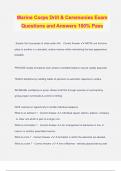Exam (elaborations)
BSN HESI 266 Med-Surg HESI Test Questions 2022/2023 and All Answers Verified Correct
- Course
- BSN HESI 266 Med Surg
- Institution
- Nightingale College
BSN HESI 266 Med-Surg HESI Test Questions 2022/2023 and All Answers Verified Correct 300+ QUESTIONS WITH CORRECT ANSWERS DOWNLOAD TO ACE
[Show more]












